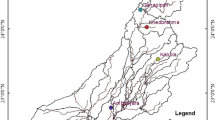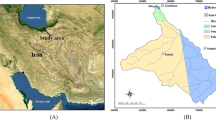Abstract
Accurate surface runoff prediction is vital for water resources engineers for various applications. Advances in the artificial intelligence techniques can act as robust tools for modelling hydrological processes. The present study focuses on testing the reliability of different data sources and choosing the correct source to model the rainfall-runoff process under data scarce situations using AI techniques. In this study, an absolute homogeneity test was performed for TRMM, gridded and observed precipitation data and found that the observed precipitation dataset is homogeneous and best suitable for modelling rainfall-runoff process in Kallada river basin, Kerala. Emotional artificial neural network (EANN) is a novel hybrid neural network and it is suggested in the present study for accurate monthly surface runoff prediction. This study was also conceived to address and investigate the efficiency of EANN for forecasting monthly surface runoff and compare the performances with conventional feed forward neural network (FFNN) and multivariate adaptive regression spline (MARS) models. Suitable goodness-of-fit criteria such as Nash–Sutcliffe efficiency (NSE), root mean square error (RMSE) and coefficient of determination (R2) and graphical indicators are used for assessing the efficacy of the developed models. The results showed that the EANN model performs better with R2 = 0.80 for the training phase and R2 = 0.77 for validation phase compared to other models. The improvement in the performance of EANN model over FFNN model is 12% and 5.8% for coefficient of determination in the training and validation phase, respectively. Further, the Taylor diagram indicates that there is a close match between the observed and EANN model predicted values in terms of statistical parameters. Overall, this study demonstrated the effectiveness of EANN in modelling the rainfall-runoff process and also could be a useful technique in other fields of water resources engineering.
Highlights
-
The present study focuses on testing the reliability of different data sources such as gridded, observed and TRMM precipitation datasets and choosing the correct source to model the rainfall-runoff process using AI techniques.
-
From the selected homogeneous dataset and the observed runoff data, potential predictors were identified based on correlation analysis and partial autocorrelation function (PACF).
-
The monthly runoff prediction models were developed using three AI techniques namely FFNN, MARS and EANN in a tropical river basin (Kallada) of Kerala with scarce amount of data.
-
The performance of the developed models were assessed using statistical indicators (NSE, RMSE, and R2) and graphical indicators (Taylor diagram, REC plots and Random walk test).



(Source: Nourani 2017)







Similar content being viewed by others
References
Alexandersson H 1986 A homogeneity test applied to precipitation data; J. Climatol. 6(6) 661–675.
Asadi H, Shahedi K, Jarihani B and Sidle R C 2019 Rainfall-runoff modelling using hydrological connectivity index and artificial neural network approach; Water 11(2) 212.
ASCE Committee 2000 Task committee on application of artificial neural networks in hydrology, artificial neural networks in hydrology. I: Hydrologic application; J. Eng. 5(2) 115–123.
Aytek A, Asce M and Alp M 2008 An application of artificial intelligence for rainfall-runoff modeling; J. Earth Syst. Sci. 117(2) 145–155.
Buishand T A 1982 Homogenity of rainfall records; J. Hydrol. 58(2) 11–27.
Che Ros F, Tosaka H, Sidek L M and Basri H 2016 Homogeneity and trends in long-term rainfall data, Kelantan River Basin, Malaysia; Int. J. River Basin Manag. 14(2) 151–163.
Committee A 2000 Task committee on application of artificial neural networks in hydrology, artificial neural networks in hydrology. II: Hydrologic application; J. Hydrol. Eng. 5(2) 124–136.
Delft Hydraulics D C 2003 Operational Manual – Data Processing and Analysis (Vol. 8).
Delsole T and Tippett M K 2016 Forecast comparison based on random walks; Mon. Weather Rev. 144(2) 615–626.
Friedman J H 1991 Multivariate adaptive regression splines; Ann. Stat. 19(1) 1–141.
GSI 2005 Geology and mineral resources of the states of India PART IX–Kerala; Geol. Surv. India Misc. Publ. 211(30) 2–5.
John von Neumann 1941 Distribution of the ratio of the mean square succesive difference to the variance; Ann. Math. Stat. 12(4) 367–395.
Jothiprakash V, Magar R B and Kalkutki S 2009 Rainfall-runoff models using adaptive neuro-fuzzy inference system (ANFIS) for an intermittent river;. Int. J. Art. Intell. 3(9A) 1–23.
Kumar S, Roshni T and Himayoun D 2019 A comparison of emotional neural network (ENN) and artificial neural network (ANN) approach for rainfall-runoff modelling; Civil Eng. J. 5(10) 2120–2130.
Lotfi E and Akbarzadeh-T M R 2016 A winner-take-all approach to emotional neural networks with universal approximation property; Inf. Sci. 346–347 369–388.
Lotfi E, Khosravi A, Akbarzadeh-T M and Nahavandi S 2014 Wind power forecasting using emotional neural networks, IEEE International Conference on Systems, Man, and Cybernetics (SMC), San Diego, CA, pp. 311–316.
Nourani V 2017 An emotional ANN (EANN) approach to modeling rainfall-runoff process; J. Hydrol. 544 267–277.
Nourani V, Gökçekuş H, Umar I K and Najafi H 2020 An emotional artificial neural network for prediction of vehicular traffic noise; Sci. Total Environ. 707 136134.
Nourani V, Komasi M and Alami M T 2012 Hybrid wavelet–genetic programming approach to optimize ANN modeling of rainfall–runoff process; J. Hydrol. Eng. 17(6) 724–741.
Nourani V, Komasi M and Mano A 2009 A multivariate ANN-wavelet approach for rainfall-runoff modeling; Water Resour. Manag. 23(14) 2877–2894.
Nourani V, Molajou A, Uzelaltinbulat S and Sadikoglu F 2019 Emotional artificial neural networks (EANNs) for multi-step ahead prediction of monthly precipitation; case study: Northern Cyprus; Theor. Appl. Climatol. 138(3–4) 1419–1434.
O & M Kallada Manual 2020 Operation and maintenance manual for kallada dam; Kerala Water Resources Department.
Pettitt A N 1979 A Non-parametric approach to the change-point problem; J. R. Stat. Soc. 28(2) 126–135, https://doi.org/10.1016/j.epsl.2008.06.016.
Roshni T, Jha M K and Drisya J 2020 Neural network modeling for groundwater-level forecasting in coastal aquifers; Neural Comput. Appl. 32(16) 12,737–12,754.
Salas J D, Delleur J W, Yevjevich V and Lane W L 1980 Applied modeling of hydrologic time series, Water Resources Publications, Littleton, Colorado.
Sharda V N 2008 Performance of Multivariate Adaptive Regression Splines (MARS) in predicting runoff in mid-Himalayan micro-watersheds with limited data; Hydrol. Sci. J. 53(6) 1165–1175.
Sharghi E, Nourani V, Najafi H and Molajou A 2018 Emotional ANN EANN and Wavelet-ANN (WANN) approaches for markovian and seasonal based modeling of rainfall-runoff process; Water Resour. Manag. 32(10) 3441–3456.
Solgi A, Nourani V and Marzouni M B 2017 Evaluation of nonlinear models for precipitation forecasting; Hydrol. Sci. J. 62(16) 2695–2704.
Venkata Ramana R, Krishna B, Kumar S R and Pandey N G 2013 Monthly rainfall prediction using wavelet neural network analysis; Water Resour. Manag. 27(10) 3697–3711.
Yaseen Z, Naganna S, Sa’adi Z, Samui P, Ghorbani M and Salih S S S 2020 Hourly river flow forecasting: Application of emotional neural network versus multiple machine learning paradigms; Water Resour. Manag. 34(3) 1075–1091.
Zhang W and Goh A T C 2016 Multivariate adaptive regression splines and neural network models for prediction of pile drivability; Geosci. Front. 7(1) 45–52.
Acknowledgements
Authors would like to acknowledge Central Water Commission (CWC) and India Meteorological Department (IMD) for providing sufficient data. The authors also acknowledge the anonymous reviewers for their insightful comments and suggestions.
Author information
Authors and Affiliations
Contributions
Beeram Satya Narayana Reddy: Formal assessment, conceptualization, data collection, framework of methodology, model development, software, initial draft writing, review and editing. Pramada S K: Formal assessment, conceptualization, methodology, resources, supervision and validation. Thendiyath Roshni: Formal assessment, conceptualization, methodology, resources, supervision and validation.
Corresponding author
Additional information
Communicated by Rajib Maity
Appendix: Developed models
Appendix: Developed models

Rights and permissions
About this article
Cite this article
Reddy, B.S.N., Pramada, S.K. & Roshni, T. Monthly surface runoff prediction using artificial intelligence: A study from a tropical climate river basin. J Earth Syst Sci 130, 35 (2021). https://doi.org/10.1007/s12040-020-01508-8
Received:
Revised:
Accepted:
Published:
DOI: https://doi.org/10.1007/s12040-020-01508-8




